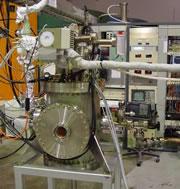 Scale up the size of this xenon liquid and gas detector and it will become more sensitive.Laboratori Nazionali del Gran Sasso
Scale up the size of this xenon liquid and gas detector and it will become more sensitive.Laboratori Nazionali del Gran SassoThe tiny, wimpy particles that might make up the Universe's dark matter must be even wimpier than some theories suggest.
The first results from an experimental technology designed to detect Weakly Interacting Massive Particles (WIMPs) — predicted candidates for dark matter — help to pin down the strength of their interactions with ordinary matter in the Universe. The work rules out the stronger estimates predicted by some models, making the WIMPS look particularly weak, and narrowing down the places that researchers still have to look for them.
The XENON collaboration announced their results at the American Physical Society's April meeting in Jacksonville, Florida, on 14 April. Their work pushes the maximum possible strength of WIMP interactions down by a factor of six from the previous record, set by the Cold Dark Matter Search (CDMS-II) experiment at the University of California, Berkeley, in 2005. The new limit is stringent enough to test some particle-physics theories of supersymmetry.
"This is the first experiment that starts to significantly cut into some of those models," says XENON spokeperson Elena Aprile of Columbia University in New York, who admits that she is surprised at how well the experiment performed.
A noble plan
The XENON10 experiment is located in the underground Gran Sasso National Laboratory in Italy. It is a prototype research device designed to test a combination of liquid and gaseous xenon as a way to detect WIMPs.
“Maybe after 80 years we will finally get an answer to this dark matter problem.”
Richard Gaitskell, Brown University
The detector consists of a layer of liquid lying below a layer of gas. When dark-matter particles enter the chamber, they collide with xenon nuclei in the liquid, causing them to emit a flash of light. The collision also loosens electrons, which emit second flash when they hit the gas layer. By watching the characteristics of these two events closely, physicists can distinguish between an incoming WIMP and a cosmic ray, muon, neutron, or any other particle penetrating the tank. Removing background noise is the greatest challenge for direct detection experiments.
After running for 58.6 days, using 5.4 kg of xenon, the researchers observed ten flashes that might have been WIMPs. But all were were found not to be dark matter after further analysis. Since the experiment is capable of seeing WIMPs down to a certain strength of interaction, this rules out those strengths — limiting our view of what WIMPs must look like.
The plan is to now make the instrument more sensitive and rule out more WIMP strengths. The team is aiming to increase their sensitivity five times by the end of the year, by running more experiments on the same apparatus, and hopes to have results from a 100-kg detector in 2009, which should increase sensitivity a further ten times. Eventually they hope to make a one-tonne detector, which will be even more sensitive - although that will be a challenge.
Competition
Other instruments are also looking out for WIMPs. Some have solid detectors and others, like XENON10, use noble gases and liquids to watch for the mystery particles. The latter are obviously showing promise, says XENON member Richard Gaitskell of Brown University in Providence, Rhode Island. "We are seeing an entirely new technology taking the lead," he says.
The competing groups agree that they need all the help they can get to make a conclusive sighting of dark matter. "This is a second technology in the running. We need that," says Bernard Sadoulet, spokesperson for the CDMS-II project, which uses solid germanium and silicon detectors to look for WIMPs.
ADVERTISEMENT
Two other experiments using noble liquids — WARP, which is also at Gran Sasso and uses argon, and ZEPLIN-II, which uses xenon and sits in an old mine in Cleveland, UK — have recently helped to shed a bit of light on dark matter. But neither saw a hint of WIMPs, nor placed tight constraints on their properties.
Gaitskell is confident about the future. "Maybe after 80 years we will finally get an answer to this dark-matter problem. This stuff will have to be truly extraordinary to avoid our combined efforts closing in on it."
Visit our matterlookstobe_partic.html">newsblog to read and post comments about this story.
